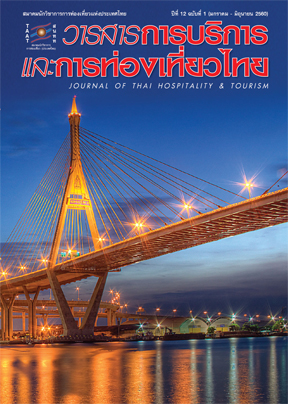ผลกระทบของความถี่ในการชมภาพยนตร์เกาหลีต่อความชื่นชอบประเทศเกาหลีและความตั้งใจที่จะเดินทางไปท่องเที่ยวประเทศเกาหลี
Main Article Content
บทคัดย่อ
ภาพยนตร์เกาหลีได้รับความนิยมเป็นอย่างมากในประเทศแถบเอเชียโดยเฉพาะในประเทศไทย งานวิจัยในอดีตได้ระบุว่าภาพยนตร์สามารถทำให้เกิดความชื่นชอบและความตั้งใจที่จะเดินทางไปท่องเที่ยวยังสถานที่ที่ถ่ายทำภาพยนตร์ ผู้ที่ได้รับชมภาพยนตร์จะมีทัศนคติในเชิงบวกต่อสถานที่ถ่ายทำภาพยนตร์เพิ่มขึ้นและความตั้งใจที่จะเดินทางไปท่องเที่ยวยังสถานที่ถ่ายทำภาพยนตร์ก็จะมีเพิ่มมากขึ้นเช่นเดียวกัน ในปัจจุบันความคิดนี้ยังไม่ได้มีการศึกษาวิจัยเปรียบเทียบระหว่างคนที่ชมและยังไม่ได้ชมภาพยนตร์ งานวิจัยนี้จึงได้ทำการศึกษาเปรียบเทียบผลระหว่างคน 3 กลุ่ม คือ คนที่ไม่เคยชมภาพยนตร์เกาหลี คนที่ชมภาพยนตร์เกาหลีมาบ้าง และคนที่ชมภาพยนตร์เกาหลีเป็นจำนวนมาก งานวิจัยนี้ได้ดำเนินการเก็บข้อมูลที่สนามบินสุวรรณภูมิกับกลุ่มตัวอย่างที่เป็นนักท่องเที่ยวชาวไทยซึ่งกำลังจะเดินทางไปต่างประเทศ จำนวน 610 คน วัตถุประสงค์ของงานวิจัยคือ การศึกษาว่า ความถี่การชมภาพยนตร์เกาหลีจะทำให้ความชื่นชอบประเทศเกาหลีและความตั้งใจที่จะเดินทางไปท่องเที่ยวยังประเทศเกาหลีมีเพิ่มมากขึ้นได้หรือไม่ ซึ่งผลของการวิจัยพบว่า เมื่อความถี่ของการชมภาพยนตร์เกาหลีเพิ่มขึ้น ความชื่นชอบประเทศเกาหลีและความตั้งใจที่จะเดินทางไปท่องเที่ยวยังประเทศเกาหลีจะมีเพิ่มมากขึ้น
Article Details
References
[2] Beeton, S. (2004). Rural Tourism in Australia: Has the Gaze Altered? Tracking Rural Images through Film and Tourism Promotion. International Journal of Tourism Research, 6(3), 125-135.
[3] Beeton, S. (2005). Film-induced Tourism. Clevedon: Channel View Publications.
[4] Beeton, S. (2010). The Advance of Film Tourism. Tourism and Hospitality Planning & Development, 7(1), 1-6.
[5] Bunnag, Orawee. & Sabaiwan, Wasawat. (2016). South Korea’s Destination Image in Attitudes of Thai Tourists. Humanities and Social Sciences Journal Ubonratchathani Rajabhat University, 7(1), 283-299.
[6] Busby, G. & Klug, J. (2001). Movie-induced Tourism: The Challenge of Measurement and Other Issues. Journal of Vacation Marketing, 7(4), 316-332.
[7] Butler, R. W. (1990). The Influence of the Media in Shaping International Tourist Patterns. Tourism Recreation Research, 15(2), 46-53.
[8] Carl, D., Kindon, S., & Smith, K. (2007). Tourists’ Experiences of Film Locations: New Zealand as ‘Middle Earth’. Tourism Geographies, 9(1), 49-63.
[9] Chuttrsakulphairatch, Vanida. (2014). The Effects of Korean TV Drama Series on Korean Values Assimilation and Culture Imitation of the Thai Youth. Panyapiwat Journal, 6(1), 175-185.
[10] Connell, J. (2005). Toddlers, Tourism and Tobermory: Destination Marketing Issues and TV-induced Tourism. Tourism Management, 26, 763-776.
[11] Connell, J. (2012). Film Tourism: Evolution, Progress and Prospects. Tourism Management, 33, 1007-1029.
[12] Couldry, N. (1998). The View from Inside the ‘Simulacrum’: Visitors’ Tales from the Set of Coronation Street. Leisure Studies, 17, 94-107.
[13] Croy, W. G. & Heitmann, S. (2011). Tourism and Film. In P. Robinson, S. Heitmann & P.U.C. Dieke (Eds.), Research Themes for Tourism (pp. 188-204). Oxon: CABI.
[14] Department of Tourism, Thailand (2016). Outgoing Thai Travellers Statistics [PDF document]. Retrieved from http://tourism2.tourism.go.th/home/details/11/221/25307.
[15] Frost, W. (2006). Brave-hearted Ned Kelly: Historic Films, Heritage Tourism and Destination Image. Tourism Management, 27, 247-254.
[16] Frost, W. (2010). Life Changing Experiences. Film and Tourists in the Australian Outback. Annals of Tourism Research, 37(3), 707-726.
[17] Hahm, J. & Wang, Y. (2011). Film-induced Tourism as A Vehicle for Destination Marketing: Is it Worth the Efforts? Journal of Travel & Tourism Marketing, 28, 165-179.
[18] Hao, X. & Ryan, C. (2013). Interpretation, Film Language and Tourist Destinations: A Case Study of Habiscus Town, China. Annals of Tourism Research, 52, 334-358.
[19] Hudson, S. & Ritchie, J. R. B. (2006). Film Tourism and Destination Marketing: The Case of Captain Corelli’s Mandolin, Journal of Vacation Marketing, 12(3), 256-268.
[20] Inchan, Noppadol. (2013). Korean Drama Series: A Case Study of Korean Culture Fever Wave in Thai Society (Doctoral Dissertation, Srinakharinwirot University, 2013).
[21] Iwashita, C. (2006). Media Representation of the UK as A Destination for Japanese Tourists: Popular Culture and Tourism. Tourist Studies, 6(1), 59-77.
[22] Iwashita, C. (2008). Roles of Films and Television Dramas in International Tourism: the Case of Japanese Tourists to the UK. Journal of Travel & Tourism Marketing, 24(2-3), 139-151.
[23] Kim, S. S. (2012). The Relationships of On-site Film-tourism Experiences, Satisfaction, and Behavioural Intentions: the Case of Asian Audience’s Responses to a Korean Historical TV drama. Journal of Travel & Tourism Marketing, 29, 472-484.
[24] Kim, S. S., Agrusa, J., Lee, H. & Chon, K. (2007). Effects of Korean Television Dramas on the Flow of Japanese Tourists. Tourism Management, 28(5), 1340-1353.
[25] Kim, S. S., Agrusa, J., Chon, K. & Cho, Y. (2008). The Effects of Korean Pop Culture on Hong Kong Residents Perceptions of Korea as A Potential Tourist Destination. Journal of Travel & Tourism Marketing, 24(2-3), 163-183.
[26] Kim, S. S., Lee, H. & Chon, K. (2010). Segmentation of Different Types of Hallyu Tourists Using A Multinomial Model and its Marketing Implications, Journal of Hospitality and Tourism Research, 34(3), 341-363.
[27] Kim, S. & O’Connor, N. (2011). A Cross-cultural Study of Screen-tourists’ Profiles. Worldwide Hospitality and Tourism Themes, 3(2), 141-158.
[28] Kim, H. & Richardson, S. (2003). Motion Picture Impacts on Destination Images, Annals of Tourism Research, 32(4), 887-904.
[29] Kim, S. & Wang, H. (2012). From Television to the Film Set: Korean Drama Daejanggeum drives Chinese, Taiwanese, Japanese and Thai Audiences Screen-tourism. The International Communication Gazette, 74(5), 423-442.
[30] Rajaguru, R. (2014). Motion Picture-induced Visual, Vocal and Celebrity Effects on Tourism Motivation: Stimulus Organism Response Model. Asia Pacific Journal of Tourism Research, 19(4), 375-388.
[31] Riley, R. & Van Doreen, C. S. (1992). Movies as Tourism Promotion: A ‘Pull’ Factor in a ‘Push Location’. Tourism Management, 13(3), 267-274.
[32] Rittichainuwat, Bongkosh. & Rattanaphinanchai, Suphaporn. (2015). Applying a Mixed Method of Quantitative and Qualitative Design in Explaining the Travel Motivation of Film Tourists in Visiting A Film-shooting Destination. Tourism Management, 46, 136-147.
[33] Roesch, S. (2009). The Experiences of Film Location Tourists. Clevedon: Channel View Publications.
[34] Shani, A., Wang, S., Hudson, S. & Gil, S. M. (2009). Impacts of A Historical Film on Destination Image of South America. Journal of Vacation Marketing, 15(3), 229-242.
[35] Smallman, C., & Moore, K. (2010). Process Studies of Tourists’ Decision-Making. Annals of Tourism Research, 37(2), 397-422.
[36] Suebsawasde, Preeyaporn. (2008). Media Exposure and Perception of Rajabhat University in Bangkok toward Culture in Korean Drama (Master’s Thesis, Thammasat University, 2008).
[37] Urry, J. (1990). The Tourist Gaze: Leisure and Travel in Contemporary Societies. London: Sage.

